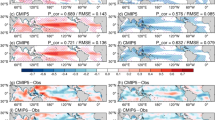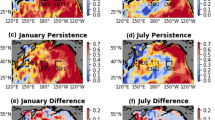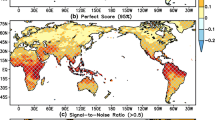Abstract
In this study, reasons for spatial variability in prediction skill of seasonal mean sea surface temperature (SST) are investigated. The analysis explores the connection between the spatial variation of SST prediction skill in tropical latitudes and local simultaneous correlation between observed SST and precipitation (SST-P). The results show that high (low) SST prediction skills and slow (fast) decay in skill with lead time are generally collocated with large positive (weakly positive or negative) SST-P correlations. The reasons for spatial variation in SST-P correlation can be explained by whether the primary forcing is from the ocean to the atmosphere or vice versa. Over regions where the ocean is generally known to force the atmosphere, it is found that SST-P correlation has large positive values. Over regions where the atmosphere forces ocean, SST-P correlation is weak due to intrinsically unpredictable nature of atmospheric variability. The physical explanation for spatial variation in SST-P correlation, and apparent link between the spatial variations in SST-P correlation and spatial variations in skill of SST predictions also establishes a physical basis for the latter. As a corollary, low SST prediction skill in coupled forecast models over certain geographical regions may be due to the inherent limits on predictability in addition to the contribution from model biases or initialization errors.









Similar content being viewed by others
References
Alexander MA, Blade I, Newman M, Lanzante JR, Lau NC, Scott JD (2002) The atmospheric bridge: the influence of ENSO teleconnections on air–sea interaction over the global oceans. J Clim 15:2205–2231
Chen J, Del Genio AD, Carlson BE, Bosilovich MG (2008) The spatiotemporal structure of twentieth-century climate variations in observations and reanalyses. Part I: longterm trend. J Clim 21:2611–2633
Chen M, Wang W, Kumar A (2012) Ocean surface impacts on the seasonal-mean precipitation over the tropical Indian Ocean. J Clim 25:3566–3582
Gadgil S, Joseph PV, Joshi NV (1984) Ocean–atmosphere coupling over monsoon regions. Nature 312:141–143
Griffies SM, Harrison MJ, Pacanowski RC, Rosati A (2004) Technical guide to MOM4. GFDL Ocean Group technical report no. 5, 337 pp. http://www.gfdl.noaa.gov/~fms
Janowiak JE, Xie P (1999) CAMS-OPI: a global satellite-rain gauge merged product for real-time precipitation monitoring applications. J Clim 12:3335–3342
Kim HM, Webster PJ, Curry JA, Toma VE (2012) Asian summer monsoon prediction in ECMWF System 4 and NCEP CFSv2 retrospective seasonal forecasts. Clim Dyn 39:2975–2991. doi:10.1007/s00382-012-1470-5
Klein S, Sode BJ, Lau NC (1999) Remote sea surface temperature variations during ENSO: evidence for a tropical atmospheric bridge. J Clim 12:917–932
Kumar A, Chen M, Wang W (2011) An analysis of prediction skill of monthly mean climate variability. Clim Dyn 37:1119–1131. doi:10.1007/s00382-010-0901-4
Kumar A, Chen M, Zhang L, Wang W, Xue Y, Wen C, Marx L, Hunag B (2012) An analysis of the nonstationarity in the bias of sea surface temperature forecasts for the NCEP Climate Forecast System (CFS) version 2. Mon Weather Rev 140:3003–3016. doi:10.1175/MWR-D-11-00335.1
Kumar A, Chen M, Wang W (2013) Understanding prediction skill of seasonal mean precipitation over tropics. J Clim 26:5674–5681. doi:10.1175/JCLI-D-12-00731.1
Peng P, Kumar A, Barnston AG, Goddard L (2000) Simulation skills of the SST-forced global climate variability of the NCEP-MRF9 and Scripps/MPI ECHAM3 models. J Clim 13:3657–3679
Reynolds WR, Rayner NA, Smith TM, Stokes DC, Wang W (2002) An improved in situ and satellite SST analysis for climate. J Clim 15:1609–1625
Richter I, Behera SK, Masumoto Y, Taguchi B, Komori N, Yamagata T (2010) On the triggering of Benguela Niños: remote equatorial versus local influences. Geophys Res Lett 37:L20604. doi:10.1029/2010GL044461
Saha S et al (2010) The NCEP climate forecast system reanalysis. Bull Am Meteor Soc. doi:10.1175/2010BAMS3001.1
Saha S et al (2014) The NCEP Climate Forecast System version 2. J. Climate 27:2185–2208. doi:10.1175/JCLI-D-12-00823.1
Timothy NS et al (2011) ECMWF seasonal forecast system 3 and its prediction of sea surface temperature. Clim Dyn 37:455–471. doi:10.1007/s00382-010-0947-3
Trenberth KE, Shea DJ (2005) Relationships between precipitation and surface temperature. Geophys Res Lett 32:L14703. doi:10.1029/2005GL022760
Wang B, Kang I-S, Li J-Y (2004) Ensemble simulation of Asian-Australian monsoon variability by 11 AGCMs. J Clim 17:803–818
Wang W, Saha S, Pan HL, Nadiga S, White G (2005) Simulation of ENSO in the new NCEP Coupled Forecast System Model (CFS). Mon Weather Rev 13:1574–1593
Wang W, Chen M, Kumar A (2010) An assessment of the CFS real-time seasonal forecasts. Weather Forecast 25:950–969
Wu R, Kirtman BP (2004) Impacts of the Indian Ocean on the Indian summer monsoon ENSO relationship. J Clim 17:3037–3054
Wu R, Kirtman BP (2007) Regimes of seasonal air–sea interaction and implications for performance of forced simulations. Clim Dyn 29:393–410. doi:10.1007/s00382-007-0246-9
Wu R, Yeh SW (2010) A further study of the tropical Indian Ocean asymmetric mode in boreal spring. J Geophys Res. doi:10.1029/2009JD012999
Wu R, Kirtman BP, Pegion K (2006) Local air–sea relationship in observations and model simulations. J Clim 19:4914–4932
Wu R, Kirtman BP, Huug VDD (2007) An analysis of ENSO prediction skill in the CFS retrospective forecasts. J Clim 22:1901–1918
Wu R, Kirtman BP, Pegion K (2009) Surface latent heat flux and its relationship with sea surface temperature in the National Centers for Environmental Prediction Climate Forecast System simulation and retrospective forecasts. Geophys Res Lett 34:L17712. doi:10.1029/2007GL030751
Zhu J, Shukla J (2013) The role of air–sea coupling in seasonal prediction of Asia-Pacific summer monsoon rainfall. J Clim 26:5689–5697. doi:10.1175/JCLI-D-13-00190.1
Acknowledgments
Thanks for Drs. Peitao Peng and Caihong Wen for CPC internal manuscript reviews and thanks for three anonymous reviewers for their thorough reviews and helpful comments.
Author information
Authors and Affiliations
Corresponding author
Rights and permissions
About this article
Cite this article
Chen, M., Kumar, A. & Wang, W. A study of the predictability of sea surface temperature over the tropics. Clim Dyn 44, 1767–1776 (2015). https://doi.org/10.1007/s00382-014-2187-4
Received:
Accepted:
Published:
Issue Date:
DOI: https://doi.org/10.1007/s00382-014-2187-4




